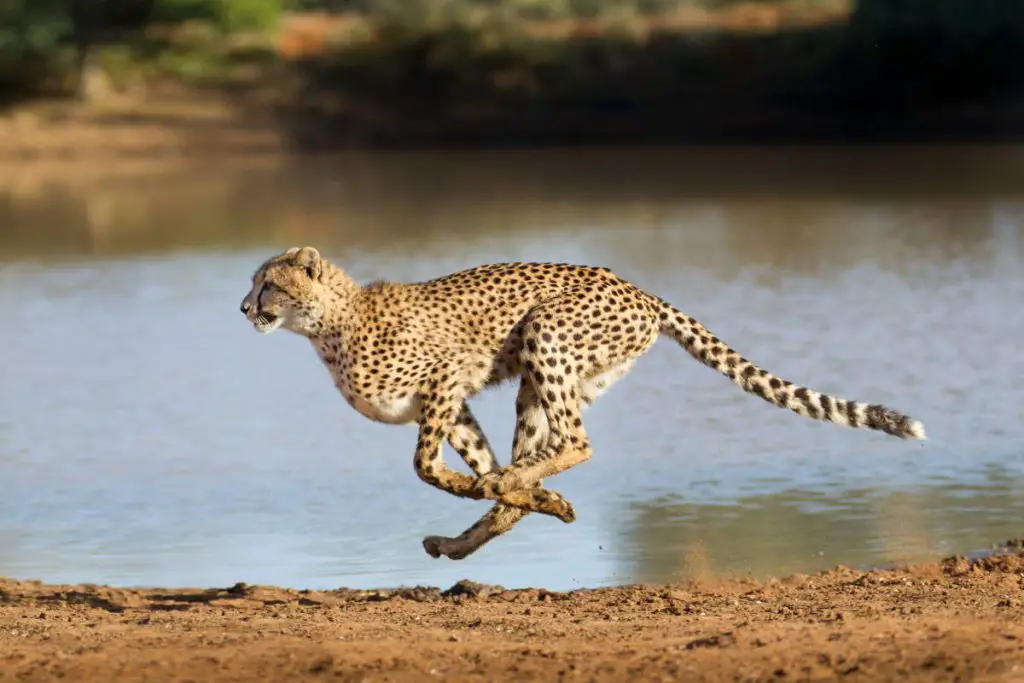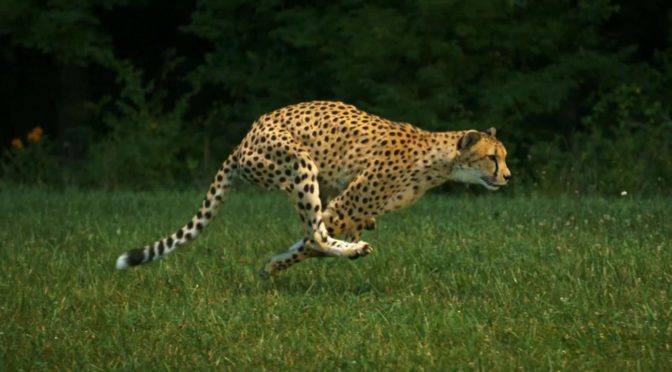The cheetah, renowned as the fastest land animal on Earth, epitomizes speed like no other creature. While we often hear of its unparalleled velocity, a question that frequently arises is: how fast can a cheetah actually run? Across various sources, speeds ranging from 96 to 120 kilometers per hour (60 to 75 miles per hour) are cited. However, the most accurately documented speed comes from an exceptional individual, a South African cheetah named Sarah (c. 2001-January 22, 2016) from the Cincinnati Zoo.
How Fast Can a Cheetah Run? [a real test result]
The highest properly measured top speed of a cheetah is 98.1 km/h (61 mph).
Sarah, who became a symbol of speed and agility, was featured in National Geographic as the world’s fastest land mammal. In a remarkable display of her abilities, she completed a 100-meter dash in just 5.95 seconds in 2012, at the age of 11, and was radar-timed reaching speeds of up to 98.1 kilometers per hour (61 miles per hour).
Her life, which came to a peaceful end on January 22, 2016, due to declining health, raises a captivating question: could she have been even faster in her younger years? As Sarah was equivalent to approximately 60 human years at the time of her record, this possibility tantalizes the imagination, though it remains a mystery we can never unravel.
Video: Sarah the cheetah breaks the speed record
Watch as Sarah, the cheetah from Cincinnati Zoo, shatters the world speed record, in the video below. Achieving a new milestone, she sprinted 100 meters in just 5.95 seconds, surpassing her own 2009 record of 6.13 seconds. Remarkably, she outpaced Usain Bolt, the fastest human ever, by nearly 4 seconds, reaching a top speed of 61 mph. Featured in National Geographic’s November 2012 issue, her extraordinary run is captured in unprecedented high-speed photos and video, showcasing the unique dynamics of the cheetah movement.
As mentioned above, Sarah was 11 when she broke the record for the fastest land animal. It equals approximately 60 human years! So,
- Perhaps she was even faster when she was younger. Unfortunately, we’ll never know.
- There must be even faster cheetahs in the wild (young healthy adults), which means that some individuals could reach or even exceed the 100 km/h mark under ideal circumstances.
Anatomy of Speed: The Evolutionary Design of the Cheetah
The cheetah’s incredible speed is not a matter of chance but a result of extraordinary evolutionary adaptations. Its body is a masterpiece of natural engineering, designed for rapid acceleration and high-velocity pursuits.
- Streamlined Body Structure: The cheetah’s slim, aerodynamic frame, long legs, flexible spine, and elongated tail all contribute to its speed. This structure facilitates air-cutting movement and balance at high velocities.
- Muscular Power: Powerful leg muscles are central to the cheetah’s explosive speed. These muscles allow for rapid acceleration, a critical factor in the wild where catching prey often depends on the first few seconds of a chase.
- Respiratory and Cardiovascular Efficiency: Adaptations in the cheetah’s respiratory and circulatory systems, such as larger nasal passages and a robust heart, enable efficient oxygen uptake and circulation. This is crucial during sprints to prevent muscle fatigue and maintain speed.
- Specialized Feet and Claws: Unlike other big cats, cheetahs have semi-non-retractable claws, offering enhanced grip during high-speed chases.
- Spring-like Spine: The spine of a cheetah works akin to a spring, aiding in lengthening strides and providing flexibility, essential for maintaining high speeds.

The Cheetah’s Speed in Context
While the figures associated with the cheetah’s speed are impressive, they represent more than just numbers. These speeds are typically sustainable over short distances, usually around 200 to 300 meters. This limitation is due to the intense energy expenditure and heat buildup that occurs during such sprints. Consequently, the cheetah’s hunting strategy revolves around short, explosive bursts of speed to catch prey, rather than prolonged chases.
Scientific Observations and Measurements
The study of cheetah speed has been thorough, utilizing high-speed cameras and other advanced tracking technologies. These studies have been conducted both in controlled environments and in the wild, allowing for a comprehensive understanding of how cheetahs move and hunt. Through these scientific endeavors, we’ve gained insights not only into the cheetah’s peak speeds but also its acceleration, maneuverability, and hunting tactics.
Reflecting on the Legacy of Sarah
Sarah’s remarkable life at the Cincinnati Zoo provides a unique window into the capabilities of cheetahs. Her speed, recorded in a controlled setting, serves as a testament to what these animals are capable of under optimal conditions. While it’s tempting to speculate about her potential speeds at a younger age, what remains undeniable is her contribution to our understanding and appreciation of cheetahs.

Conclusion
The cheetah’s speed is a testament to nature’s ingenuity, showcasing how evolution can sculpt a living creature into a model of efficiency and purpose. While the exact speeds may vary among individuals, with Sarah’s record providing a concrete benchmark, the essence of the cheetah’s ability lies in its extraordinary biological adaptations. As we continue to study these magnificent animals, each discovery adds to our understanding of their lives and the intricate workings of the natural world.
Sources
- Sarah (cheetah) on Wikipedia
- “Cincinnati Zoo Says Goodbye to World’s Fastest Cheetah” on the Cincinnati Zoo’s official website
- “World’s Fastest Cheetah Dies-Watch Her Run” on the National Geographic website
- Moon Landings: All-Time List [1966-2025] - February 2, 2025
- What Is Max-Q and Why Is It Important During Rocket Launches? - January 16, 2025
- Top 10 Tallest Rockets Ever Launched [2025 Update] - January 16, 2025

